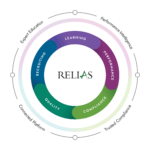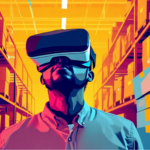Extended Reality (XR) — an umbrella term that includes Virtual Reality (VR), Augmented Reality (AR), and Mixed Reality (MR) — has transitioned from being merely a futuristic idea. In 2025, XR is swiftly revolutionizing various sectors, altering the ways we work, learn, play, and interact. With projections indicating the global XR market will exceed $100 billion this year, it is apparent that this immersive technology is maturing from being a niche market to becoming essential.
Let’s explore the primary XR trends influencing the future of digital reality in 2025.
1. Enterprise XR Adoption is Going Mainstream
In 2025, XR extends beyond just gaming or entertainment. Companies in healthcare, manufacturing, retail, and real estate are adopting XR solutions to boost productivity, cut costs, and improve customer experiences.
- The healthcare sector is utilizing VR for surgical training, pain alleviation, and mental health treatment.
- Retailers are implementing AR for virtual fittings and engaging in-store interactions.
- Manufacturers are using MR for real-time machinery diagnostics and staff training.
- The return on investment (ROI) of XR in business operations is becoming clearer, facilitating quicker and wider acceptance across sectors.
2. Spatial Computing and AI-Driven XR Experiences
XR in 2025 is becoming increasingly intelligent — due to the incorporation of Artificial Intelligence (AI) and spatial computing. AI is improving object identification, gesture recognition, and awareness of surroundings, enabling devices to offer more contextually aware, flexible experiences.
With Apple’s Vision Pro and Meta’s new Quest headsets, spatial computing is facilitating smooth interaction between tangible and digital components. This results in more intuitive user interfaces, voice-activated environments, and hands-free processes — particularly advantageous in areas such as architecture, engineering, and logistics.
3. The Rise of Immersive Collaboration
Remote working is a permanent fixture, and XR is transforming how teams collaborate online. In 2025, virtual meeting spaces, 3D whiteboards, and digital twins have become standard instruments for remote teamwork.
Platforms like Microsoft Mesh and Meta Workrooms are fostering immersive environments where team members can engage as avatars, brainstorm in shared 3D spaces, and enjoy greater connectivity than traditional video calls can provide.
This trend is revolutionizing employee engagement, training, onboarding, and even customer assistance by introducing a layer of presence and interactivity that flat screens cannot replicate.
4. XR in Education and Training
Education is experiencing a significant evolution with XR. Immersive learning is not just captivating — it is also effective. In 2025, we observe:
- Virtual classrooms that enable students to delve into historical events or intricate scientific concepts in 3D.
- AR-enhanced textbooks that animate static visuals.
- Corporate XR training that replicates real-world situations for customer service, technical abilities, and safety measures.
- This experiential learning approach enhances retention and offers a safe setting for practice, making it a preferred choice for educators and trainers alike.
5. 5G and Cloud XR Powering Mobility and Scalability
- A significant obstacle for XR adoption has been limitations in hardware and bandwidth. However, with the widespread rollout of 5G and advancements in edge computing by 2025, XR is becoming increasingly mobile and scalable.
- Cloud XR enables devices to transfer processing tasks to the cloud, lessening the reliance on high-performance headsets.
- 5G networks provide extremely low latency and quicker data transfer, facilitating uninterrupted XR experiences on smartphones and wearable technology.
- This movement is creating opportunities for more cost-effective, lightweight, and easily accessible XR solutions, particularly in emerging markets.
6. The Expansion of XR Content Creation and UGC
As an increasing number of users interact with XR, content creation is booming. Platforms are enabling creators to craft immersive experiences without requiring programming abilities. No-code tools and user-generated content (UGC) are leveling the playing field in XR development. Whether it involves creating a virtual art gallery, developing an AR filter, or generating 360° video content — creators in 2025 have unprecedented chances to engage with the XR ecosystem, partner with brands, and profit from their work.
7. Privacy, Ethics, and XR Regulation Are Important Issues
With significant immersion comes substantial responsibility. As XR becomes more embedded in everyday life, issues related to data privacy, mental health, and digital identity are escalating. In 2025, governments and technology firms are collaborating to create ethical standards, enhance transparency in data gathering, and ensure consent-based tracking. Prioritizing user safety and emotional wellness in immersive settings has become imperative — particularly for younger demographics.
Final Thoughts
The XR environment in 2025 is vibrant, immersive, and increasingly focused on humanity. What began as a curiosity is now transforming how we live and work. As technology progresses, businesses, creators, and consumers must remain adaptable and knowledgeable to realize the full potential of digital reality.
Whether you’re a marketer delving into virtual storytelling, an educator embracing immersive learning, or a brand seeking to enhance customer interaction — the future of XR is here, and it’s more tangible than you may believe.
Quelle:


